We have prepared excellent Solutions to NCERT Class 6 Science Curiosity Chapter 10 for you, along with additional questions keeping in mind students’ and NCERT’s requirements. The additional questions include very short answer type, short-answer type, long-answer type, fill in the blanks and match and pair type questions and will help clear your concepts and prepare you for any exam.
Solutions to ‘Let us enhance our learning’ (Page No 203) of NCERT Class 6 Science Curiosity Chapter 10 Living Creatures: Exploring Their Characteristics
1. List the similarities and differences in life cycles of plants and animals.
Solution:
The similarities in the life cycles of plants and animals are:
(i) Growth: Both plants and animals grow undergo a growth phase, where they increase in size and develop further. For example, seeds grow into new plants and an embryo grows into an adult in case of animals.
(ii) Distinct Stages of Development: There are distinct stages of development in case of both plants and animals. For example, in case of plants germination of seeds occur, the plant gradually bears flowers, fruits and seeds. In case of insects such as mosquitoes, the different stages are egg, larva, pupa, adult mosquito.
(iii) Maturity: Both reach a mature stage where they are capable of reproduction.
(iv) Response to Stimuli: Both plants and animals respond to external stimuli. For example, shoots of plants grow towards sunlight and roots grow away from it and humans blink when bright light is flashed on their eyes.
(v) Reproduction: Both plants and animals reproduce. Plants reproduce to form seeds and animals reproduce to produce eggs or newborns.
(vi) Death: Both plants and animals die at the end of their life cycle.
The differences in the life cycles of plants and animals are:
(i) Mobility: Animals can move from one place to another, while plants cannot.
(ii) Nutritional Needs: Plants produce their own food via photosynthesis, while animals eat plants and other animals.
(iii) Respiration: Plants breathe through tiny openings called stomata present in leaves, while animals breathe through specialised organs such as lungs, gills etc.
(iv) External Conditions: The germination and growth of plants is heavily dependent on external conditions such as heat, light, water, and soil nutrients whereas animals rely on food, habitat etc for growth.
(v) Dependence of Offspring on Parents: Offsprings of plants do not depend on their parents for food, while animals depend on parents for nutrition during the early stage of their lives.
(vi) Regeneration: Some plants can regenerate from parts of themselves (e.g. cuttings growing into new plants), while most animals cannot regenerate by themselves in this way.
2. The table on the next page shows some data. Study the data and try to find out examples appropriate for the conditions given in the second and third columns. If you think that an example for any of the conditions given below is not possible, explain why.
| S. no | Does it Grow? | Does it Respire? | Example | Remarks |
| 1. | No | No | ||
| 2. | No | Yes | ||
| 3. | Yes | No | ||
| 4. | Yes | Yes |
Solution:
| S. no | Does it Grow? | Does it Respire? | Example | Remarks |
| 1. | No | No | Stone | Non-living, hence does not grow or respire. |
| 2. | No | Yes | Not possible | If an entity respires, then it is living and we know that all living beings grow. |
| 3. | Yes | No | Crystals of alum. | You can obtain crystals of alum by cooling a solution with alum dissolved in it. The crystals gradually grow in size. Since, alum is non-living, it does not respire. |
| 4. | Yes | Yes | Humans | Humans are living beings, hence they grow and respire. |
3. You have learnt that different conditions are required for seed germination. How can we use this knowledge for proper storage of grains and pulses?
Solution:
We should follow the steps below for proper storage of grains and pulses to prevent them from germinating:
(i) Moisture Control: Germination requires water, hence the seeds should be kept in a dry place and any contact with moisture should be avoided.
(ii) Temperature Regulation: Germination requires high temperature, hence the seeds should be kept in a cool, dry place.
(iii) Oxygen Limitation: Germination requires oxygen as well, hence the seeds should be placed in airtight containers to minimize the exposure to oxygen.
4. You have learnt that a tail is present in a tadpole but it disappears as it grows into a frog. What is the advantage of having a tail in the tadpole stage?
Solution:
Tadpoles live in water, hence the tail helps the tadpoles swim efficiently in water. It also helps them escape from predators.
5. Charan says that a wooden log is non-living as it cannot move. Charu counters it by saying that it is living because it is made of wood obtained from trees. Give your arguments in favour or against the two statements given by Charan and Charu.
Solution:
Arguments Against Charan’s Statement:
(i) Movement is not the sole indicator of life. Many organisms cannot move but exhibit growth, reproduction, respiration, response to stimuli etc.
Arguments Against Charu’s Statement:
(i) Once the tree is cut down, the wooden log no longer exhibits the characteristics of living organisms, such as growth, reproduction, respiration, photosynthesis etc. Hence, it is non-living.
6. What are the similarities and distinguishing features in the life cycles of a mosquito and a frog?
Solution:
Similarities:
- The life cycles of both consist of distinct stages.
- The life cycles of both the frog and mosquito start from the egg.
- Both start their life cycles in water.
- Both end in death.
Dissimilarities:
- Each stage in the life cycle is different. In case of a mosquito, they are egg, larva, pupa, adult. In case of a frog, they are egg, tadpole, froglet, adult.
- Duration of the life cycles are different. The adult mosquito may survive for only 10 to 15 days, while the lifespan of a frog is much longer.
- Adult mosquitoes can fly. Adult frogs are amphibians, i.e. they live on both water and land.
7. A plant is provided with all the conditions suitable for its growth (Fig. 10.9). Draw what you expect to see in the shoot and the root of the plant after one week. Write down the reasons.
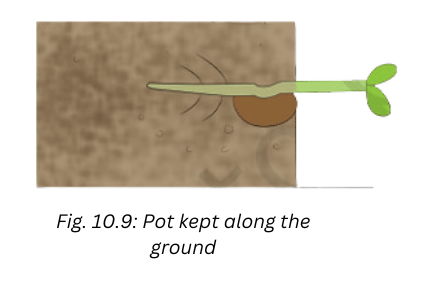
Solution:
After one week you will see something similar to what is shown below:
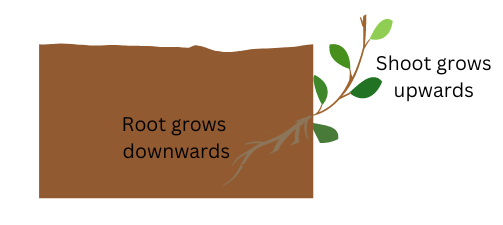
Shoot: The shoot grows upwards in response to the stimulus of sunlight. New leaves begin to appear, which prepare food and help the plant grow bigger.
Root: Roots will grow downwards away from the sunlight due to downward gravitational pull. This helps the roots absorb water and minerals from the soil.
8. Tara and Vijay set up the experiment shown in the picture (Fig. 10.10). What do you think they want to find out? How will they know if they are correct?
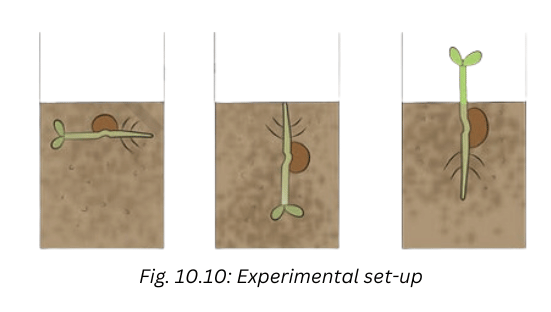
Solution:
Tara and Vijay want to find out how the orientation in which the seed is planted affects the direction of growth of the shoot and root of the plant.
Prediction:
Tara and Vijay predict based on what they learnt in class that in case of all three plants, shoots will grow upwards towards the sun and roots will grow downwards away from the sun.
Observations (After 1 – 2 weeks):
Left Pot (with horizontally planted seed): After 1 – 2 weeks, it is observed that the shoot bends upwards and grows towards the sunlight and the root bends down and grows away from the sunlight.
Middle Pot (with seed planted upside-down): After 1 – 2 weeks, it is observed that the shoot bends and grows vertically upwards towards the sunlight and the root bends and grows vertically downwards away from the sunlight.
Right Pot (with seed planted in upright position): After 1 – 2 weeks, it is observed that the shoot continues to grow in the upward direction towards the sunlight and the roots continues to grow downwards away from the sunlight.
Conclusions:
After 1 – 2 weeks, Tara and Vijay can conclude based on the observations that their predictions were correct. Regardless of the direction in which the seeds were planted, the shoot always grew upwards towards the sunlight and the roots always grew downwards away from the sunlight.
9. Design an experiment to check if temperature has an effect on seed germination.
Solution:
We can design the following activity:
Aim: To check if temperature has an effect on seed germination.
Materials Required: 30 identical seeds, 3 identical containers, water, electric heater, refrigerator.
Procedure:
(i) Fill each container with the same amount of soil.
(ii) Place an equal number of seeds (e.g., 10 seeds) in each container.
(iii) Keep the first container at room temperature inside a room.
(iv) Keep the second in a room warmed by the electric heater set to around 30o C.
(v) Keep the third one is a cold fridge set to approximately 4°C.
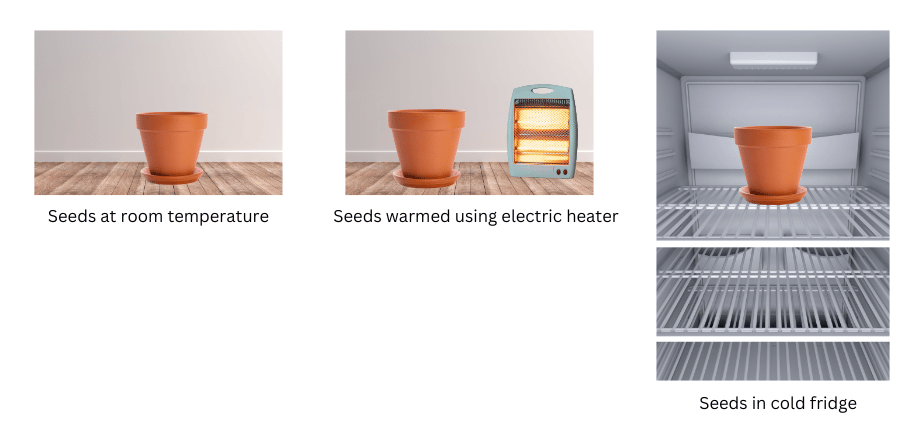
(iv) Ensure all containers have the same level of moisture by watering them equally as needed.
(v) Use thermometers to regularly check and record the temperature in each environment.
(vi) At the end of one week record the number of seeds that have germinated in each container.
(vii) Compare the germination rates and times across the different temperature environments and conclude what is the optimal temperature for seed germination.
Expected Outcome:
- Seeds in the heated room germinate faster than those in the room temperature and cold fridge.
- Seeds in the cold fridge may germinate more slowly or not at all.
Solutions to In Text Questions of NCERT Class 6 Science Curiosity Chapter 10 Living Creatures: Exploring Their Characteristics
1. (Page 191) How would you now categorise a seed, as living or non-living?
Solution:
A seed is living because it carries out life processes such as respiration and grows into a plant. Seeds respond to environmental stimuli such as water and temperature, which trigger the germination process.
2. (Page 202) Do you think that birds also show significant changes in the various stages of their life cycle?
Solution:
Yes, birds show significant changes in the various stages of their life cycle. The different stages are egg, hatchling, fledgling, adult.
3. (Page 202) How does the life cycle of animals differ from that of plants?
Solution:
The differences in the life cycles of plants and animals are:
(i) Difference Stages of Development: Many animals go through distinct stages such as egg, larva, pupa, and adult. The plant life cycle typically includes stages such as seed, germination, seedling, mature plant, flowering, and seed production.
(ii) Mobility: Animals can move from one place to another, while plants cannot.
(iii) Nutritional Needs: Plants produce their own food via photosynthesis, while animals eat plants and other animals.
(iv) Respiration: Plants breathe through tiny openings called stomata present in leaves, while animals breathe through specialised organs such as lungs, gills etc.
(v) External Conditions: The germination and growth of plants is heavily dependent on external conditions such as light, water, and soil nutrients whereas animals rely on food, habitat etc for growth.
(vi) Dependence of Offspring on Parents: Offsprings of plants do not depend on their parents for food, while animals depend on parents for nutrition during the early stage of their lives.
(vii) Growth: Animals stop growing after a certain stage. Plants grow throughout their lives.
(viii) Regeneration: Some plants can regenerate from parts of themselves (e.g., cuttings growing into new plants), while most animals cannot regenerate by themselves in this way.
Extra Questions to Complement Solutions to NCERT Class 6 Science Curiosity Chapter 10 Living Creatures: Exploring Their Characteristics
Very Short Answer Type Questions:
1. Name a non-living object that moves.
Answer:
A car is a non-living object that moves.
2. How do plants respire?
Answer:
Plants respire via tiny pores called stomata.
3. You see a plant wound around a steel rod in the garden. What type of a plant is it?
Answer:
The plant is a climber.
4. Why are there small water droplets on the surface of grasses and roses?
Answer:
There are small water droplets on the surface of grasses and roses due to excretion of excess water and minerals by these plants.
5. Name a plant that responds to the stimulus of touch.
Answer:
Mimosa.
6. Which of the following conditions is not essential for the germination of bean seeds: light, enough air, enough water.
Answer:
Presence of light is not essential for the germination of bean seeds.
7. Name two plants whose seeds require light to germinate.
Answer:
Coleus and Petunia are two plants whose seeds require light to germinate.
8. Name two plants whose seeds require darkness to germinate.
Answer:
Calendula and Zinnia are two plants whose seeds require darkness to germinate.
9. Where do mosquitoes lay eggs?
Answer:
Stagnant water bodies.
10. Name the stage that precedes an adult mosquito.
Answer:
Pupa is the stage that precedes an adult mosquito.
11. Which of the stages in the frog’s life cycle involves the development of legs while still retaining a tail?
Answer:
Froglet is the stage in the frog’s life cycle which involves the development of legs while still retaining a tail.
12. How does the habitat of a frog change during its life cycle?
Answer:
During its life cycle, a frog’s habitat changes as it progresses from living entirely in water as a tadpole to living both in water and on land as an adult frog.
13. How are frog eggs different from other eggs you may have seen?
Answer:
Frog eggs are often found in a cluster and are surrounded by a jelly-like substance, unlike the hard-shelled eggs of birds or reptiles.
14. Which stage of the frog’s life cycle has the shortest duration?
Answer:
The embryo stage has the shortest duration.
15. Name two things organisms cannot live without.
Answer:
Two things organisms cannot live without are respiration and food.
16. What is the process of elimination of wastes from the body called?
Answer:
The elimination of wastes from the body is called excretion.
17. Do animals reproduce their own kind?
Answer:
Yes, animals reproduce their own kind.
18. What is the process by which living things give birth called?
Answer:
The process by whichliving things give birth is called reproduction.
19. Do non-living things react to stimuli?
Answer:
Non-living things do not react to stimuli.
20. According to the text, what should we do to contribute to the flourishing of the living world?
Answer:
We should nurture and preserve the homes of plants and animals to contribute to the flourishing of the living world.
Short Answer Type Questions:
1. Unlike animals, plants do not move from one place to another. Do you consider them as living?
Answer:
Yes, plants are considered as living because they respire, grow, require nutrition, reproduce to form new plants and ultimately die. Even though plants do not move from one place to another, they do show certain types of movements such as opening of flowers.
2. How does the Drosera plant trap insects?
Answer:
The saucer-shaped leaves of Drosera plant have hair-like projections of unequal length with sticky ends. Whenever an insect enters the saucer, hairs move inward and hold the insect in place with their sticky ends.
3. Give examples of plants which fold their leaves after sunset.
Answer:
Examples of plants which fold their leaves after sunset are Acacia, Albizia and Mimosa.
4. When is a living being said to be dead?
Answer:
When a living being is not able to exhibit movement, growth, respiration, excretion, response to external stimuli and reproduction, despite the availability of all resources (like food, air and water), it is said to be dead.
5. Why does excess water prevent the germination of seeds?
Answer:
When there is too much water, the air spaces within the soil are filled with water instead, reducing the availability of oxygen. Since seeds need oxygen for respiration, they cannot germinate.
6. Name two measures one can take to prevent breeding of mosquitoes.
Answer:
Since mosquitoes lay eggs on stagnant water, the breeding of mosquitoes can be prevented by not letting water collect in desert coolers, planted pots and any open container. In case larva and pupa are observed in stagnant water bodies, kerosene oil should be sprayed on them. Kerosene oil forms a thin layer over the water surface and does not allow larvae and pupae to inhale air and as a result they die.
Long Answer Type Questions:
1. Pictorially represent the life cycle of a silk moth.
Answer:
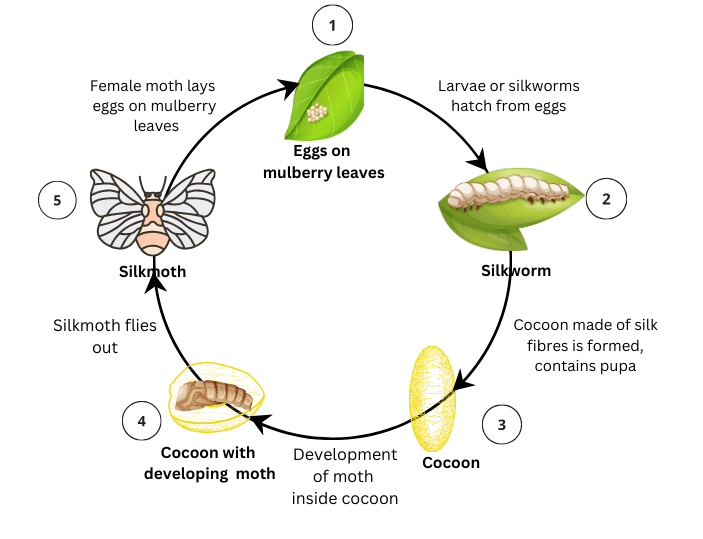
2. Describe the different stages in the life cycle of a bean plant. What changes happen in the bean plant after the final stage and why?
Answer:
The different stages in the life cycle of a bean plant are:
Stage 1 Seed: The life cycle starts with a seed.
Stage 2 Seed germination: Roots and shoots begin to appear.
Stage 3 Appearance of leaves: Small leaves begin to appear.
Stage 4 Appearance of flowers: Small flowers begin to appear.
Stage 5 Appearance of fruits: Pods containing seeds begin to appear.
Stage 6 Death of Plant: The plant eventually dies after producing fruit.
The stages are shown pictorially below:
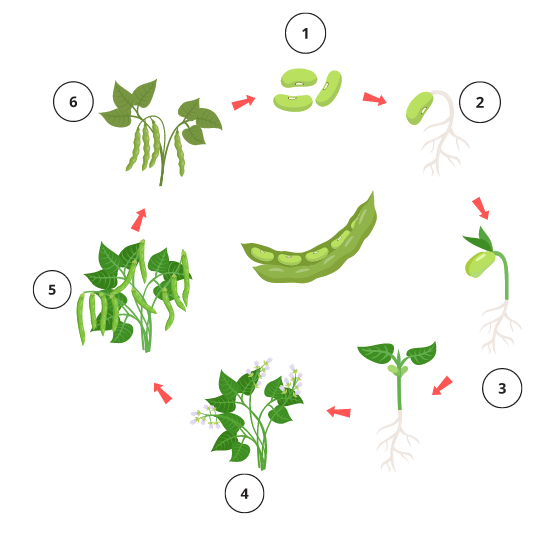
After the final stage, i.e. after producing fruit, the bean plant becomes yellow and dry even when you continue watering it. This happens because the plant reallocates nutrients to the growing fruits, instead of the other parts of the plant.
Fill in the Blanks:
respiration, spawn, tadpole, urine, Drosera
(a) _________ is an example of an insectivorous plant.
(b) Breathing is part of a process called _________.
(c) _________ is a form of excretion in animals.
(d) The jelly-like substance found on the surface of the pond, which is a cluster of frog eggs is called _________.
(e) The second stage in the life cycle of a frog is _________.
Answers:
(a) Drosera is an example of an insectivorous plant.
(b) Breathing is part of a process called respiration.
(c) Urine is a form of excretion in animals.
(d) The jelly-like substance found on the surface of the pond, which is a cluster of frog eggs is called spawn.
(e) The second stage in the life cycle of a frog is tadpole.
Match and Pair:
| Column A | Column B |
| (i) Indian gooseberry | (a) Chikungunya |
| (ii) Seed | (b) Non-living |
| (iii) Soil | (c) Amla |
| (iv) Jagadish Bose | (d) Living |
| (v) Mosquito | (e) Crescograph |
Answer:
| Column A | Column B |
| (i) Indian gooseberry | (c) Amla |
| (ii) Seed | (d) Living |
| (iii) Soil | (b) Non-living |
| (iv) Jagadish Bose | (e) Crescograph |
| (v) Mosquito | (a) Chikungunya |
++++++++++++++
Frequently Asked Questions (FAQs) on NCERT Solutions to Class 6 Science Curiosity Chapter 10 Living Creatures: Exploring Their Characteristics
In addition to the exercise questions, we have included a comprehensive set of extra questions which cover the chapter from all angles. We suggest you study them thoroughly to understand the concepts behind them. They will prepare you well for your exams.
Also, you can download the free PDFs of the solutions anytime! There’s plenty more helpful material on the way, so keep visiting our website and join our email list to be among the first to receive them!
The following topics are covered:
10.1 What Sets the Living Apart from the Non-living?
10.2 Essential Conditions for Germination of a Seed
10.3 Growth and Movement in Plants
10.4 Life Cycle of a Plant
10.5 Life Cycle of Animals
– 10.5.1 Life cycle of a mosquito
– 10.5.2 Life cycle of a frog
Yes indeed! We have provided a free PDF of NCERT Solutions Class 6 Science Curiosity Chapter 10 Living Creatures: Exploring Their Characteristics for you to download! The PDF contains the entire material we have prepared for you, including the extra question set! Please look towards the top of the page!
Understand and memorise the characteristics which separate living beings from the non-living such as movement, growth, nutrition, respiration, excretion, response to stimulus, reproduction and death. Study the essential conditions for germination of seeds well. Study the life cycles of the plants and animals given in the textbook and memorise the different stages. You will see questions from these areas in your exams. Want to learn and practise more? Study the extra problem set we have given you as it will give you a taste of what exam questions might look like.
Need any additional help? Our expert teacher-mentors are there for you anytime you need them! Feel free to reach out to us anytime and let us help you out!
At educationroundtheworld.com, we provide you access to expert teaching and academic and career mentoring – all in one place and at no extra cost. Sounds good? Contact us anytime and let us assign you a friendly ‘teacher-mentor’! We provide expert one-on-one coaching and mentoring to you depending on your convenience and needs – have it completely your way! Book an appointment now!


